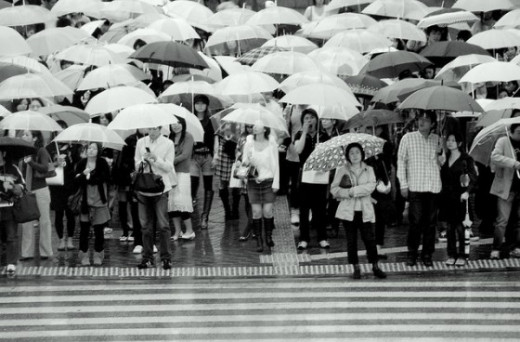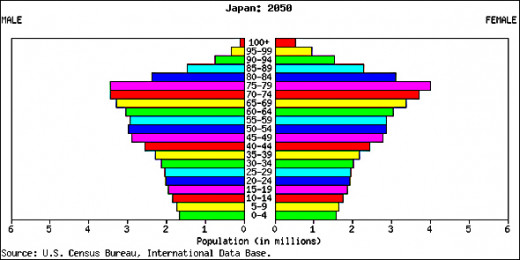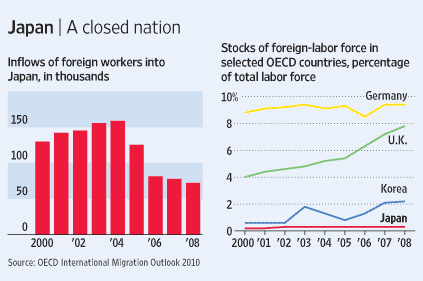Japan's Falling Population

Although the total population of the world has now reached 7 billion there are some countries where the population is stagnant or even falling, including Japan.
The population of Japan has been declining gradually since 2004 but a recent report predicts that numbers will plummet in the next 50 years. It estimates that the current population of about 128 million will reduce dramatically so that by 2060 it may be only 87 million, 30% smaller than today's figure.Almost 40% of these people will be age 65 or older. The institute also predicts that if the decline continues, Japan will have a population of only 43 million in 100 years.


Why is the population falling?
There are three reasons for this decline: age, fertility and immigration.
AGE
More than 22% of Japanese are 65 or older and a further 30% are over 40. These people have already had their families, leaving only about 30% of the population in the normal age group for having children.
FERTILITY
Many Japanese women are choosing to have small families or not to have children at all. The fertility rate, which is currently about 1.3 children per woman, is well below the replacement of 2.08 needed to maintain the current population. Some women choose to marry later than women in earlier generations - perhaps in their late 20s - and then they may put off having a child for a few years. Others choose to stay single, wanting a career and higher pay instead of a family. This means there are fewer children being born.
IMMIGRATION
Immigration is extremely low in Japan and much lower than in many other developed or higher income countries. In fact, only about 2% of the population are migrants compared to about 12% in the UK. Migrants not only increase the number of people in a country, they tend to also have a high fertility rate, as many migrants are young adults who start a family once they have settled in their new countries.

Impacts
Even though Japan is densely populated, the falling and ageing population is causing many problems both economically and socially.
PENSIONS AND HEALTHCARE
As people live longer there are increasing numbers of old people. Average life expectancy in Japan is currently 86 for women and 79 for men but this is expected to increase to 90 for women and 84 for men within 50 years. There are already about 47,000 people who are over the age of 100, including the world's oldest man Jiroemon Kimura who is 115.
Having so many old people places a tremendous strain on the Japanese government, which must fund pensions and healthcare. As the number of working people falls there are fewer tax payers and therefore less money available for social care. The problem will get worse soon as the Japanese 'baby boomers' reach 65. This group is made up of the peak numbers of people born between 1947 and 1949, after the end of the Second World War so they will all have reached 65 and qualify for a pension by 2014.
DEBT
The funding problem is made worse because Japan, like many developed countries, has a large and growing public debt, estimated at $12 trillion in 2011, which is the highest in the industrialised world. The government also incurred huge costs in the aftermath of the earthquake and tsunami in March 2011 and the resulting Fukushima nuclear meltdown.
RECRUITMENT PROBLEMS
Another big problem for Japan is the falling number of people who are of working age, meaning there are simply not enough people to fill all the available jobs. Businesses are finding it difficult to recruit new staff and this could lead to a shrinking economy, which will affect the country's prosperity further.
In the countryside, the effects of the democratic shift are already being felt and in some villages the proportion of old people is double the national average. Young people are leaving for the cities, schools are closing, buses are running less often and the only new buildings are likely to be old people's homes.
There are signs of change in the cities too. In northern Tokyo, the Sugamo shopping arcade has been built with a focus on older people, containing mainly small shops and stalls selling traditional food, clothes and health products and no burger bars, music shops or coffee chains.
Some businesses have started to respond to the changing demographics. Japan's version of Disney's magic kingdom has introduced a cut price annual pass for anyone aged 60 or over as they attempt to attract grandparents bringing their grandchildren. They are also offering activities specifically targeted at this older age group.


What can be done?
Politicians in Japan have known about the changing demographics of the country for many years but they have been reluctant to face up to the problems. Many people believe they have done too little too late to tackle the problem. Steps taken so far include:
- raising the retirement age from 60 to 65, in order to reduce the amount the government spends on pensions.
- doubling the 5% sales tax and using the extra money to help fund rising social care costs.
- passing a new law allowing fathers to take up to 8 weeks paid leave after the birth of a child, giving parents the right to take time off work if their child is ill and obliging employers to give parents the opportunity to work flexi-time.
The government is now developing policies to encourage people to work beyond the age of 65. Some people choose to continue working, often part-time or on a self-employed basis, but in the future the contribution of older people to the economy will be much more important as the working population declines. There are lots of jobs but if there are not enough people willing to do them, the government may have to raise the retirement age again.

More Migrants?
Many people think that unless attitudes towards immigration change, companies will struggle to fill jobs and the country's economy will suffer. Japan's leading businesses have called for up to 6 million foreign workers to be allowed to settle in the country and a group of leading politicians has published a report stating that the country must open its doors to migrants in order to survive.
However, migrants remain a tiny proportion of the population and many Japanese people are against increasing these numbers as they fear it will threaten their culture. Foreigners are not always made welcome and strict immigration laws, including a requirement for migrants to speak and write in Japanese, keep numbers down. There are many Indonesian and Filipino people who come to work in care homes or as nurses but most cannot stay permanently because of these language tests.
Relaxing immigration laws and raising the retirement age again are both unpopular proposals. If the government tries to introduce these changes it risks losing popularity and votes, and this is one reason why so little has been done to tackle the problems of the ageing population.

The Wider Picture
Japan's population may be ageing faster than any other country but it is not the only place facing these sorts of problems. Italy also has a large proportion of older people and a low birth rate, as does South Korea, Taiwan, and several Eastern European countries.
Some people are predicting that China's population may fall within the next 10 years as the one-child policy slows down population growth. Although currently it has a very young and vibrant population, China could soon have the largest ageing population the world has ever seen and similar problems to those facing Japan today.








